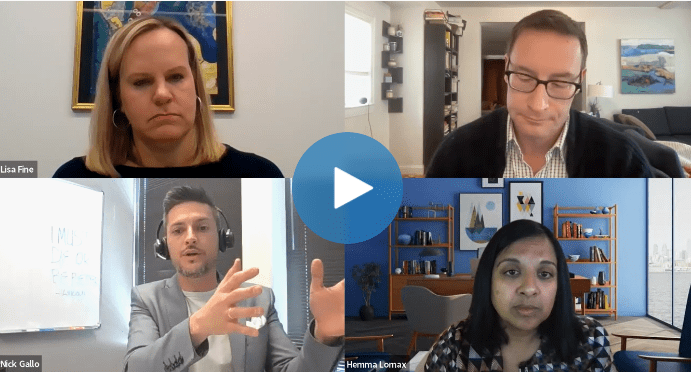Defining & Calculating the ROI of Compliance


The more precisely a compliance officer can express the ROI of compliance, the more resources you can secure from senior leadership and the stronger your program will be. In this masterclass, we’ll consider how to do that: the numbers that should go into an ROI calculation, the models and tools one can use, and other intangible benefits of a strong culture of compliance
Transcript for Defining & Calculating the ROI of Compliance
Matt Kelly: Good afternoon, everybody. We are letting all of the attendees trickle in and we have a lot so we’re gonna stall for good 30 seconds or so here. But welcome to our master class today on the ROI of compliance hosted by ComplianceLine. Nick, Nick Gallo, co-CEO and Co-Founder of ComplianceLine, I don’t know if you wanna give any welcoming remarks before we introduce our guests and dive in but…
Nick Gallo: Yeah. Thanks, Matt. Really excited for this. This is one of my favorite topics to talk about. I think it’s such a powerful language for us to be fluent in and I think it can drive a lot of persuasion in our organization, ultimately drive a lot of strategic impact if we can do it right. So, I’m excited to dive in with Lisa and Matt and Hemma. I think you guys are gonna walk away with some really…it’s really actionable information, it’s really actionable perspectives that you can bring to your organization.
And we’re also doing one of our famous book giveaways which maybe I’ll kinda keep peppering throughout the meeting. But Lisa Fine wrote an amazing book called Sending the Elevator Back Down. We’re gonna be giving away five copies of that book. Our world famous ComplianceLine book giveaways for the webinar for the best comments, for the best participation, the best questions in the chat. So, jump in. Let’s break the ice on that chat and talk about where you’re from. Say hello from where you’re from and with that, I’ll pass it back to you, Matt.
Matt: Sure. All right. So, while everybody is getting situated and coming into the conference here, here’s what we are going to talk about for the next hour, is the ROI of compliance programs. I think most compliance officers would say, “Well, of course, it’s important. We all know it’s important. And we all know that the ROI must exist because it’s very easy to say that if you don’t have a compliance program, you have a disaster, that’s going to be a total mess.” But how would you actually try to quantify it? How would you try and fit ROI calculations into the pitch that you’re going to be making, to the CEO or to the board or to other parts of the enterprise about why we should be engaging in compliance, the investments we should make. Those are the sort of questions we’re going to have.
We have two great speakers with us in addition to me, Matt Kelly and Nick Gallo. We have Lisa Fine who is from Pearson, the education publisher where Lisa is Senior Counsel and Director of compliance. So, Lisa, hello.
Lisa Fine: Hi. Hi. Thanks so much for having me.
Matt: Sure. And also joining us is Hemma Lomax. And Hemma is the Senior Corporate Counsel for Integrity and Compliance at Snapchat. So, Hemma, thanks for joining us, too.
Hemma Lormax: Pleased to be here. Thanks.
Matt: All right. So, I see a whole bunch of people here who are popping in on the chat. That is great. As always, we encourage a very interactive discussion here. So as Hemma, Lisa, Nick and I talk about what we are thinking through with ROI of compliance, if you have your own thoughts, we’d love to hear them. Pop them into the chat. Sometimes I have been really impressed and surprised by how much the chat kinda takes on a life of its own during our discussion. And if you have any questions, we will get to questions either at the end…we’ll set aside some time for questions but also if you have questions and you pop them in and they are especially timely, we might just try and answer them on the fly. So that’s what we’re looking to do.
Broadly speaking, what we want to try to talk about here today are some of the bigger picture arguments that you would make for investing in compliance that clearly there are some non-quantifiable returns on investing in compliance in a better corporate culture, better performance, lower employee turnover, things like that. But what are some of those arguments and how valuable are they really? Also what are some of the more quantifiable ways that you could make an ROI calculation? If we spend this much money on this much technology, we would save this much in labor and resources and we would get this better performance. How do you do those calculations? How much do senior executives want to see those? Things like that. That’s what we’re looking to get at here.
So, if you have any thoughts about it, chime in. We’ll be happy to work them in as much as we can. But, first, I will pose this sort of kickoff question. I guess maybe first to Lisa, then to Hemma, then to Nick. How would you even try to define the ROI of compliance? Because as I said, you can define it several ways, you know, such as dollars saved, or bad things that never happened. or a greater spirit of feeling like you’re on the right side of things. You know, what arguments…or how would you define what ROI is and what do you think are the more persuasive ways that you’d wanna talk it up? Why do you pick one argument over the other about what ROI is, why it’s important? Lisa, what do you say first? And then Hemma, and then Nick.
Lisa: So, you decided you would just kick off the light question with me? So, with that, I’m gonna get…I think there’ll be a little bit of lawyerliness in this answer but I think your ROI…the first thing you wanna think about is why is the ROI of compliance in your compliance program to your organization. I think if you start by thinking about it as a one size fits all, I’m going to say X or Y amount of dollars you’ll save with this hotline or this or that, you’re not gonna end up pleasing or helping anyone.
I think the most important thing to establish that is looking at what your company needs and what are some, you know, some initial ways to really address those sort of concerns. I think that talking about it from a general perspective as well as why it is important to be an ethical corporation and how it is to tie that in with ESG and with your employee base is a much more effective way because I can’t say…I mean, sometimes people will say that, you know, ethics and compliance or whatever…however you define your function, “Oh, you’re a cost center.” I say we are a revenue protector. And we’re helping to build the business in that manner.
But I can’t come in and say, “You’re going to save X amount of dollars.” Or, you know, “We are going to make sure that we do the following things and these are important from a baseline standpoint.” But the reason I go back to that first sort of it depends point is what your key returns on investment to some degree will also really rely upon what you’re doing. So, for me in Pearson and education, that may be different than in pharma. So that’ll be my kickoff with that.
Matt: Hemma, what do you think about…when we say ROI of compliance, how do you try and define it and explain it to others?
Hemma: Yeah. You know, it’s kinda scary, isn’t it, because are you gonna quantify what you do and your value but I think that really is the question. What is it we’re selling? And then how can you quantify that? And I don’t…you know, I completely agree with Lisa. What we’re selling really is responsible business conduct and a brand and contributing to the holistic environment that elevates that brand. What I’m really trying not to sell is fear. A lot of times we talk about what penalties you might be avoiding or what fines you might be avoiding but I don’t think that really resonates with leadership.
I think what you need to do is think about what they’re thinking about, talking their language, aligning with their values and then ensure that you’re helping them along. So, I like to say to my business partners, “You’re building the plane. You get to decide how far it goes and where it goes and how fast, but I am helping you take off, fly safely and land safely. So, I’m facilitating that.” I don’t want to come across as I’m the breaks. I’m the expensive breaks.
Instead, what I am is I’m the facilitator of ethical decision-making, responsible business conduct, brand elevation. And then that can be quantified because then you’re actually moving with the business and quantifying your value alongside their goals and their…and what thing I love to do is align with the objective and goalsetting of the company because if you’re a part of that, then you are critical part of any growth, a critical part of any elevation of the company. You want the company to feel they can’t do that without you.
Matt: Nick, what do you think?
Nick: A great point. I think that’s a great point. I think there is…I just think this is…you know, this is not 1996 anymore. So, everybody has policies. Everybody has hotlines. Everybody has a code of conduct. All those things can obviously incrementally be improved. But there’s so many opportunities around, in the forefront, in the headlines for us, great resignation, ESG, et al, for us to take advantage of and weave into our path of persuasion to get what we need in our organizations.
So, I think many times we kind of stick to our kind of binary risk focused mentality when we’re thinking about these things and that ends up limiting what we can sort of take credit for as we’re talking to a CFO or as we’re talking to the board or to the CEO to get more, you know, to get more whatever. Like, budget or tools or people on your team or whatever. And what I think it comes down to, just to kinda nerd out on it a little bit, is, like, we are usually…broad brush stroke, we’re usually only comfortable making high confidence interval claims, right.
I can say with a high confidence that this policy is gonna keep us out of trouble. Obviously, you need to have that kind of thinking when we’re talking about, like, a clear line between, you know, legal and illegal, whatever. But we can blur that line and speak a little bit more in the gray to people who live in that gray, who are making investments, who are doing acquisitions, who are kind of comfortable making sort of bets that they don’t know the sort of binary outcome with and start to take credit for some things that are a little bit further afield.
So, whether there’s things like Hemma’s talking about of improving brand awareness or, you know, some things that she was talking about yesterday in our show flow conversation of, you know, being a center for, you know, ethical decision-making or actually just good decision-making, right. Those are things that we can start to take credit for and I think we’ll get to this a little bit more, start to attach some dollars and cents to it. Because at the end of the day, it doesn’t matter whether we’re right or wrong or what.
We’re saying what ultimately matters is the destination in this path of persuasion that we’re embarking on and can we get what we want? Is that more integration in the organization? Is that more strategic impact? Is that a seat the grown folks’ table where, you know, no cost centers are at, right? There’s a bunch of organizations or departments within our organization that have traversed, that have made that journey that we can learn some things for along the way but it’s about repurposing it for our…in the context of what we can affect. To Lisa’s point, in the context of the business and what’s important to them.
So, I just think it’s about focusing on who we’re selling to, recognize that we are persuading at the end of the day and this is one sort of color on the palette that we can pull from to paint the picture of, you know, the impact that we wanna have.
Matt: Well, it’s interesting because we already have some comments here coming in on the chat from listeners several of whom say they love the idea of revenue protector. Lovely phrase. Or brand elevation. But somebody else here who really likes something you said, Hemma, where their feedback was, “It is easy to identify the penalties but it is better to identify the potential for growth.” Which, I agree with that but on the other hand, I also kinda thought, like…I thought identifying the fear would be kinda good. Maybe that’s just me and my news media perspective.
But just this morning, I was writing about an SEC action against a mining company where they had terrible compliance, led to a mining disaster. It’s cost billions of dollars, killed hundreds of people down in Brazil. And, like, that could at least motivate some people, I would think, but maybe I’m wrong that, you know, it is easy to call out mistakes and disasters but is it also easy for other executives to say, “Well, that’s not gonna happen here. So, we’re not gonna buy into that argument.”
I don’t know. Hemma, what do you think about that idea of, you know…color it in a little bit more for us. Don’t sell fear, do sell potential for growth. What do you think about that?
Hemma: I’d love to. So, let’s talk about the fear for a second. I was at the Securities and Exchange Commission in the enforcement division for 11 years. So, I’ve been on the other side. I can sell fear all day. I know how it goes wrong…how bad it can get and I can tell you some of the insight as to what we think about that. But as you said, I don’t want the conversation to go on likelihood of getting caught, likelihood of being on the radar. Are they going after us? I think that really takes the conversation in a completely different direction which is far away from the culture and values and ethical decision-making that we want in everyday decisions.
I’ll also say, right, I’ve worked at Disney. I’m working a…I’ve chosen these big brands that care about the reputation of their brands and will probably be hurt more quickly by social media than they will by regulators. Like, if something comes out about what they’re doing or they don’t care or they’re thinking about getting caught, they’re gonna be in trouble.
And so, I like working here because they’re willing to put time and resources and effort behind their brand long before a regulator might come knocking on their door. I think that’s critical. So, fear has its place but, really, it’s so remote. It’s like talking about earthquakes…well, maybe not in California but it’s like emergency planning for an emergency. We don’t wanna spend money and time on my fire kit, you know, my emergency plan. What we want to do is think about what we are doing today.
And so, if we focus on what the business exists for, the objectives and goals of the business and then think of…look, the business people know to think about opportunity but, of course, you can’t think about opportunities to growth without risks. What might get in my way? Penalties is just one thing further down the line. And as you know, for better or for worse, people pay penalties and they move on. That doesn’t actually change ethical decision-making. And so, I feel like if you come at it with the fear and the regulators, you’re gonna be stuck in that conversation and you are gonna be resigned to, “Oh, they’re the emergency planning people if we get in trouble.”
I feel like as lawyers and compliance professionals, we can support on a more holistic way and we can actually add value in a much more critical way. I like to work with our teams when they’re thinking about their goals and their opportunities and then making sure they’ve thought about the risks that might occur in the actual activities they’re doing, not the FCPA case…”Wall Street Journal” but what they’re doing in their jurisdictions, in their business activities. And it’s really more personal. Obviously, things aren’t static. They’re going to continue to think of new opportunities.
And so, me, sitting in my office in corporate, I’m not gonna know that unless I’m there with them where they think about these new activities, and at the same time, think about emerging risks. That’s a very different conversation to, “Oh, my goodness. What if one of our people goes rogue and gets us in trouble?”
Lisa: And I’m gonna add a point in there as well. I’m just gonna jump in because I see a lot of the comments talking about…there are times for fear. There is time…fear isn’t always just fear. I don’t…wouldn’t want to sound like the, you know, the speaker of doom but sometimes those concerns are a reality and a business reality. People need to be aware of them. It’s a question of who you’re talking to and what risks you’re talking about. And to really talk about it as, you know, what are those concerns. How do we handle specific issues? And sometimes some people need to understand that these things can happen even when they’re like, you know, “We’ve got all these systems. This could never happen to us.”
Now a lot of people on this call…and I’m also…thank you, Kristy Grant-Heart. You said in the comments exactly what I was thinking about. But sometimes there might be a pocket in your organization or somewhere else where you’re sure it can’t go wrong and then things escalate. And then everyone’s like, “How could it ever happen?” Yep.
And somebody just put in my favorite…you know, never waste a good crisis. So, you’re going to have something in your organization that’s not going to go right. If you don’t ever have something that goes wrong, then either you’ve ran all these panels for us or you’re not aware of what’s happening in some pocket somewhere. But when it does help and you have real-life examples of what you have to do to solve something and then you can build the relationships and work to maintain after the fact so you can continue being goal oriented in the future. But I do think we can’t, unfortunately, be 100% always, you know, as…we won’t always be growth oriented or always be positive, but we also as a gatekeeper for certain things, we do have to make sure people are aware of what are risks and what is illegal.
Matt: You know, so one person here in the chat chimed in, what I thought was a great way to phrase it. Listen, leadership does not listen to fear. They are risk takers to begin with because that’s how they’ve grown their business. And we need to speak to what they… Excellent point.
Nick: Yeah. You’re not gonna motivate somebody who’s a risk taker, who is an entrepreneur, who has claimed their way up by taking sort of calculated risk by just talking about all the downside. You know, again, this is a broad-brush stroke but if you’re talking to a board of directors that are other entrepreneurs or you’re talking to a CEO who is relatively less risk averse, we have to kind of fight against this sort of logical fallacy that we all have which is everybody’s like me. And odds are people that are relatively more risk averse oversample in the audience that is here, right.
Ethics and compliance probably oversamples with risk averse people, whereas sales, just to draw a distinction, probably has people that are way less risk averse, right. They’re willing to take risks, they’re willing to get out over their skis and so forth. So, if we sell to them, if we try to persuade a group of people that are, you know, significantly different than we are in a way that would persuade us, we’re gonna…we’re only gonna resonate with a couple of folks that are actually wired like us. There’s probably a diverse audience. There’s probably a bunch of different motivations and understanding those things and understanding how those folks are wired with a more balanced approach like Hemma and Lisa just talked about will allow you to touch on some of that fear.
Absolutely, we need to talk about the downside but also talk about the upside and also talk about the fact that, you know, there’s no… we were talking yesterday. Like, if your brand is public, the court of public opinion doesn’t afford due process. So, if you come across as unethical, you’re done. So hey, how can we reinforce these things? How can we create a culture that reinforces this brand that we’re trying to push out through our marketing and so forth? How can we decrease the turnover that we’re experiencing in the great resignation? How can we improve employee engagement? Those are the types of things that are growth oriented, that are, you know, opportunities that are probably gonna resonate a little bit more with people that are a little bit less risk averse.
Matt: So, let me ask one question. How are the arguments for the ROI of compliance…or, you know, the advocacy for good compliance function, how do they differ between what you say to the first line operating units…because they’re not gonna set your budget but if you come to them and they don’t think compliance is important and they don’t bother with it, you know, that’s gonna be a recipe for disaster. But are there different arguments you would make to them about why compliance is worthwhile versus the more dollars and cents that you might make with the second line of, you know, legal or HR or IT or to the CEO and the CFO about what the budget’s going to be?
You know, let me keep going with…I’ll start with Hemma and then Lisa and then Nick, circle back with some of the bigger picture thoughts about that. But the difference between the operating units and the management units. You know, how do those conversations flow?
Hemma: It’s a really interesting question, Matt. I would venture to say they’re exactly the same. I don’t think there needs to be a differentiation there because again looking at it is a holistic brand, brand ambassadors…everyone’s a brand ambassador. Everyone could do damage. You know, it flows up and if you can’t trust the people on the front line, what difference does it make? So top down, to up, I think it’s just…it’s the same message.
Now the question is what’s the…You talked a little bit about that. I think there does need to be balance. I just want…I wanted to flag something. So, the U.S. government has put out a number of anti-corruption initiatives in the last couple of years. Yesterday, they put out one…the State Department put out one called responsible business conduct. Now, just using those two phrases…if I come to you talking about anti-corruption all of a sudden, you know, there’s a visceral response, a defensive response. If I come to you talking about responsible business conduct, there’s a sense of shared values, pride, empowerment.
You are actually contributing to the bottom line no matter where you are in the company because you are part of a responsible business conduct ethic. That’s why I think the message has to be the same. Also, we want the communication. We want our ambassadors, we want the people on the ground saying it was a worthwhile conversation with Hemma. I feel like I’m empowered to do business. I can make money for the business and also feel good about myself and feel good that I’m protecting the brand. If I’m getting that across the lower levels, that will escalate. They will do the advocacy for me.
Nick: Totally right.
Matt: Lisa, what do you think?
Nick: Totally right.
Lisa: I do think there’s a distinction in that what people are going to be doing in response or thinking about from the compliance request is different, as you said, you’ve got the leadership. Let’s…you know, thinking about big picture. Maybe you have to…having to deal with some of the things they believe are arduous processes that go along with your procedures. And, you know, for some people, I think the difference in it is…and I mean, there’s a lot of great aspirational things that, you know, you talk about. You get people proud of the company, you wanna be an ethical organization.
I think most people want to do the right thing but they also have a lot of things they need to do to get through the day. And putting in your gifts in hospitality preapproval or something else to them sometimes seems like a… I’m an ethical person. Why are you doing this? So, I think in that approach really talking to people about the why and help people understand it’s not just that, you know…
We’re all real excited every day to look at 1,000, you know, different…or your team…these, you know, requests. Snd from a U.S. standpoint, different states have different requirements or other things. And we want you to understand that and sometimes even on that level to say…because I don’t want you to walk into a meeting with someone who might be a public official thinking you’re being a great person offering them a meal when you can’t do that in their state and they have to say no to you or, you know…but I’m just saying that’s not necessarily…I’m gonna be able to say this would be quantifiable but the fact that people trust the reasoning that you’re explaining that as opposed to them thinking, “Wait, the company doesn’t wanna spend money on my lunch, my lunches but they’ll do it for the C-Suite?”
No, it’s, like, you’re having a lunch in X state and these are the things that you need to be aware of so that you can keep doing your job. I mean, while I do think the message should always be consistent and similar at all levels, I think the why might be a little different. And the more you target that to people, the more comfortable they are to avoid the problems.
Nick: Can you tell that story, Lisa, that you told yesterday? That was, like, such a powerful refrain you did with that guy. You know what I’m talking about?
Lisa: Oh, yeah. I had a conversation with somebody. And to be fair, this was pre-Ukraine war but it was, you know, post-COVID. And it’s hard to sometimes remember when these things…but I had to talk to somebody in some detail about a variety of different issues at which point the person basically decided to explain to me everything that was wrong with sanctions, laws in terms of limiting profitability and being outside the U.S. and understandably, you know, part of the tension of that is you don’t get it because your country is the one who’s giving these requirements that’s making me lose money as a salesperson.
So, you know, I listened for a while. I said, “You know what? From a personal standpoint of the organization, I would be thrilled if you can make as many sales as possible because my bonus, my compensation…the better we do, the better I do personally.” But that, on the other hand, doesn’t mean that I can opine or tell you how we, you know…they’ll change the law so you can do that and the problem with that on a couple of levels is one, we could…you know, you’re doing something that’s illegal.
I can’t change the legality but I would like us to be more profitable at any time. And, you know, and then I said something that somebody put in here that an old boss of mine said. I saw it in the chat, too. The orange doesn’t look good on you. You know, do I…
Nick: Orange is not your color. Yeah.
Lisa: Orange is not your color. It’s not your color. But what happened in the conversation is his response was, “I never really thought about it that way that, you know, more of you protecting all of us as opposed to you stopping certain business objectives.” I said, “Listen, I can’t give you…you know, I can’t change the policies of several governments but I can make sure you don’t get in trouble and that we continue to do the right thing and make profits.” And I think that was…for him, he was like, “I like you. I didn’t think I would.” So, I was like, “Okay. Thank you, I think.”
Nick: There’s a compliment in there somewhere, yeah.
Lisa: Somewhere, right.
Matt: One area, one line of thinking I had about dealing with the first line is there is some certain sense…and I think there’s a lot of value in the raw material of people wanna be on a good team. We are one of the good guys or the good ones, not the bad, slimy ones who will violate every law just so we can win a contract. Like, they like that. And I think it’s important to try and encourage it but I also wonder how does the compliance officer go from, “We all wanna be on the right side,” to, “So now we’re going to ask you, first line employee, to engage in these procedures for travel and expense reports which are a pain in the neck.” They always are. You know, I’ve been there myself.
But, you know, how do you go from that raw material of support? Sure, I’d like to be an ethical person to do all these steps and we’re going to translate that. For the CFO, I’m gonna ask for this, this and this to get a budget request from my compliance program. Like, how do you try and figure out that gap from, we all wanna be ethical to you’re going to have to do these things and we’re gonna have to spend this much money on it? Nick, what do you think there?
Nick: Yeah, everybody wants to have a beach body. Nobody wants to eat a salad. So, at some point, you have to do the healthy things to do it, right. And the company’s culture is just the amalgamation of everyone’s beliefs and thoughts and actions and all that kinda stuff. So, I think, you know, Hemma and Lisa have said kind of implicitly a couple of times this…taking the time to talk to people and give them the why behind the what and provide the context and reframe this sort of bad brand that ethics and compliance has had as the sort of breaks on the plane or whatever that analogy is as something that’s. really, I’m allowing you to run faster. I’m allowing you to…you know, you can drive very fast down the road if you know where the clear lines on the side of the road are so you don’t careen off the cliff or something, right.
So, like, us drawing those lines for folks should be an empowerment to them but many times they have a misconception like Lisa’s new friend had. And I think putting that others focus and understanding… Again, you can never persuade anybody unless you understand where they’re coming from. Taking that time to understand what they care about and what’s important to them allows us to be way more persuasive and do those reframes or, you know, do kind of what Lisa’s talked about or what Hemma’s been able to do across different departments in their organization. But it starts with that others focus and that underpinning of trust, I think.
Hemma: Look, I was gonna use exactly that word, it’s trust. I mean, trust and curiosity, and let me just venture and say to the compliance professionals in the audience sometimes we get it wrong, right. Sometimes our procedures are too burdensome and we don’t know that because we’re not communicating and talking. So why not ask how can we get what I need, the why, how can we get that quicker and more efficiently?
I learned a lot from our businesses by coming with this great form but it’s 50 questions long. You know, like, what can we do to make it actually doable? Again, move that playing faster together while ticking our boxes. I think sometimes we think sacrosanct. Like, we’ve created this procedure and it must be done. Well, the SEC does not tell you how it should be done nor does the DOJ, right. That’s the thing. So, we take the guidelines and we turn them into these very burdensome processes and we say, “That’s something that you cannot change.” And that’s just not true. We’re growing as compliance functions. We need to listen.
And if we say we need to see every meal over X amount and then we learn that that’s a million meals a year, you’re probably getting in the way. And all of a sudden, it’s not about bad decision-making. It’s not even about breaking the law. It’s about not being able to keep up with the processes we’ve put in place. So, I think there’s a lot of trust building to be done.
And I’ll just go a bit further in terms of what we’re selling as a function. We are then selling…skills build skills, right? Skills building, decision leadership, speaking up, curiosity, being willing to break something that’s been there for a while and do it better. If we can ferment those skills in our teams, that’s a massive value add. That’s leadership development, leadership skills. I think any CEO would be proud to know that his teams feel empowered to have those conversations and get things right. Not buying against the cost center but saying, “We’re working together with the cost center.” And to your point, Matt, I want my staff to say to the CEO, “Yeah, Hemma was curious…what we saw, and she came up with a better solution because she listened to us.”
Lisa: And I’m gonna jump in on one other thing about this quickly from the top. I was looking at some people talking about the importance of the policies and understanding policies. I also think it’s really incumbent upon us to make things that are understandable to them and also to look at different ways and methods of making sure people will understand those things. Because it’s part of their day. It’s not the same thing. Just like I’m not living and breathing over certain aspects of sales. So, making sure that they will understand and also if there are limitations and systems. You know, I think this is, Matt, going back to your question of, you know, how do you make the business case for the budget or for the money down the line. Okay, I’ve worked with the business. Here’s what works well.
Here are the pressure points and here are our main concerns and be able to focus on that when you talk to senior leaders of this is why this is going to benefit not just us because a lot of times some of the things frankly that would help us the most may be really truly behind the scenes. But, you know, if it’s something like improving your due diligence or if it’s something like that, if people find that their process is easier and they’re getting the results they need and they’re staying out of trouble, they’ll be really happy about that.
And going back to the policies, like, I’m just gonna say for Hemma, currently, if anyone hasn’t looked at the Snap’s new code of conduct that goes around their value of being kind, it really says so much about what the company wants to be as aspirational. But I also think it, you know, puts them out there in a way and I’m sure there was a lot of budget discussions talking about how to do something as cool as that. And at the end, it really shows, you know, in the tech world…and I’m not in that world. You know, one company, it is a little bit of a differentiator. So yes.
And I see…yes, it’s like kids taking an exam. Yeah, also sometimes you just gotta repeat a lot of things and spend a lot of time. So Matt, I’ll jump back to you.
Matt: I did wanna call out one really great point that a commenter made a while back now. But they did say part of why you should invest in compliance is because it makes you a better business partner. And that is such an important point because all we talk about most of the time in the compliance world is vetting other third parties to weed out the undesirable ones. And the more you invest in compliance, the more you are one of the desirable ones. I like to say we are all somebody else’s third party. And the better you can be as a third party, of course, they’re going to pick you because that’s all we talk about most of the time is how to find those third parties.
I did want to pivot a bit to some of the more quantitative analyses that people will need to make to try and figure out where to invest, in what sort of resources, how to make that business case to the people who sign off on the budgets. You know, how could one calculate the, say, the costs of a manual process and then evaluate…well, if we automate this, we’re gonna save this much more money and things like that.
Now, Nick, I’m gonna put you on the spot because I know you think about this a lot and in a prior life, you had a lot of audit experience and audit work where you’re crunching numbers and doing analyses. Like, talk to us about how you would quantify in, I don’t know, dollar terms or however about the ROI of these kinda projects. What do you do?
Nick: I think the first thing you do is you open your mind for indirect or second order impacts that whatever we’re talking about can have. So, I think this framework is kind of helpful. Think about it as a three-tier framework of these are…so what is the ROI formula, right? It’s some return, it’s some positive on top and it’s investment, some dollars out the door on the bottom. And we want that ratio to be as high as possible. Is making that numerator as big as possible relative to whatever that denominator is?
So, if you think about that numerator, let’s break it up into three different categories. One is basic 1996 style ethics and compliance program full-on risk aversion, right, of lawsuit avoidance, penalty avoidance, fines that we’re not gonna have, lawsuit, you know, whatever. You know, us getting sued. That, off the table. So that’s first category.
Second category is gonna be an efficiency metric. So how are we able to do something faster? Are we able to do the same amount of work with less people? Are we able to do more work with the same people because now we have some efficiency? Are we able to get some new visibility into analytics, some kind of a dashboard, you know, whatever? Are we gonna be able to do quicker reporting or have reports at our fingertips? Those are all kind of efficiency centric values, right? So that’s the second one.
First one’s, you know, risk aversion. Second one is efficiency. And the third one is what I’ll broadly put into culture. This is sort of, like, impact compliance. And here, again, these are a little bit further afield than the direct kind of simple lever of us, you know, putting a policy in place that’s going to, you know, reduce our risk of getting sued or something like that. But these are things…you know, so the culture piece, I think, we can boil down and with kind of high confidence talk about two different aspects of it.
Where is a good culture gonna show up? I think one is gonna show up in employee engagement and one is gonna show up in employee turnover. And given…I can even talk about ESG. That also can fall into this bucket but there’s a… you know, you just have to get a little bit creative. The employee turnover piece in the context of the great resignation, it’s happening everywhere, okay.
It’s happening all over the place, right. ECI’s report from last year said that 79% of people who spoke up experience actual retaliation. This is not fake retaliation. This is actual retaliation. That’s almost doubled from the two or three years prior to that. So, there’s some level of retaliation going on in your organization. There’s some fear of retaliation that’s getting people to consider and be part of the 63% of folks who are looking for a new job, right.
So, if we can diminish that, if we can reduce that turnover, we can really save a ton of money and that all falls to the bottom line because think of what hiring costs are, think of what ramp up costs are, think of what loss of productivity costs are as you replace somebody on your team. It probably takes six months to maybe even a whole year for someone to get to the same rate of output regardless of role as the person that they are, you know, replacing, right. So, if you can curtail that a little bit, all that falls directly to the bottom line and we can get into sort of the nuts and bolts of it but the other side of the fence, and this is the silent killer in our organizations, you know, is employee engagement.
And look, the generational shift that we’re talking about, like, that extra money or that extra time that Hemma and the Snap team put into that code of conduct, who is that for? Was that so that the compliance team could nerd out or so that the compliance team could look like stars to the other compliance programs? Absolutely not.
This is an organization that’s forward-thinking enough to recognize that the people coming into their organization care about the type of organization they’re working at, are willing to prioritize kindness or willing to prioritize culture or willing to prioritize being, you know, on the good team as Matt was saying earlier because it’s one brand. The internal employee experience and the external brand, it’s one thing. So, spending those extra dollars on building out a cohesive, compelling, persuasive code of conduct is part and parcel with the kind of culture that you’re trying to create.
So not only are you gonna attract the type of talent that’s willing to go on the journey that you’re trying to do but those people are gonna be willing to push their foot on the gas a little bit more, right. Employee engagement across the economy depending on how you measure it is at about 70%. That means people are pushing down on the gas pedal 70%. If you can get people on average to push 72%, that extra 2% of the full salary that you’re paying all falls to the bottom line.
Take a portion of credit for that for your numerator. Your turnover is 25% and when it historically has been 15%…if you can have a more ethical culture within 18 months, make the argument to say, “Hey, listen, I’m not saying we’re gonna get back to 15%. This may be the new normal but hey, CEO, you think we can reduce it 1% with a more ethical culture?” That 1% multiplied by the impact that all that turnover has, that falls directly to the bottom line.
So, when we start to expand the dimensionality of our impact beyond the fearmongering of let’s not get sued to something that’s like, “Hey, we’re gonna be a differentiator. If we can engage in this authentically, we’re gonna attract the better talent and these people are gonna put their heart into their work and we’re gonna separate from our competitor that has the same asset set and the same cost of capital and the same resources and the same go-to-market strategy as we are because we’re authentically creating an environment that fosters the type of, you know, work and heart of people that we’re trying to bring into the fold.”
Matt: So, Nick, I do feel like you should pick up a pen and do the math on the whiteboard behind you for everybody…
Nick: Okay. Okay. Okay.
Matt: Now I did wanna call out one comment that one attendee made here, Carly, saying, “All the lawyers hear “quantitative” and they start to feel afraid. But it truly is hard to quantify funds saved from avoiding fines and lost business.” I see that point for Carly but I do think that, you know, what Nick just walked through about, enhanced efficiency, you know, that is not difficult to quantify. If you could accelerate, say, your documentation to get through all the questionnaires your customers are giving you because you’re their third party and accelerate that for more onboarding of your business to be their customer, like, they’re going to like that. That’s something that can be done.
But let me circle back now. First Hemma and then Lisa. How do you try and think through the more dollars and cents parts if CFO is saying, “I’m not opposed to what you want but, you know, give me an ROI calculation. Show me some numbers.” You know, how would you actually try to work through that?
Hemma: Well, this would be the comment that said…numbers, quantitative. Like, oh, because, you know…just logically you’re like, “What if I calculate it and it shows that I’m not worth my time?” Like, so there’s that, too, because I do say it because we have these lofty ideas as compliance professionals, but are we actually delivering is one question I have to ask myself before I start quantifying. Then I loved what you said there in terms of the second order and the second factor kind of benefits because I then can stop and say, “What would I like to…” People say what measure gets done, but what would I like to do and measure is a different question.
And so, if you want to impact retention, for example, and the good news is I think you picked up on this, Nick, is the data’s out there, right. The data is out there for the great resignation. We can then do ethical culture and engagement surveys internally and get that data and then show an improvement internally year on year, and really think about where the deficiency is, where is at 70, where we can get to 72 or vice versa. And what can we contribute?
So, you can really use the data that’s available to you internally and externally to think about what’s important to you as a function. But there’s no data available to me about how many employees pay the bribe, right. That’s not available to me but in terms of how many employees didn’t have the conditions that might want them to pay a bribe like dissatisfaction, lack of engagement, discrimination, harassment, retaliation. Those things are actually very important when we think about the behaviors we tend to hone in on. So, get that data. Ask yourself what you want to do and then to Nick’s point, find out how you can measure it. And there are some simple ways to do that. Go ahead, Nick.
Nick: Yeah, and I was just gonna say, keep in mind, that the people…again, broad brush stroke. If you’re talking to a CEO that’s making a $100 million acquisition or a $200 million acquisition, they don’t have some magic crystal ball where they know with confidence that margins aren’t gonna contract or that the sales growth that the acquisition target has previously enjoyed are not going to fall off. They make calculated bets around…that are based on certain assumptions.
So, I’m saying in your persuasion path, you can collaborate with the audience and say, “What do you think this is?” I mean, 10% improvement in employee engagement in 12 months, that seems kind of high, right? Yeah, that does seem high. What about 1%? Does that seem, like, achievable? Does that seem conservative? If they say yes, I’m just telling you the math is gonna work out in this particular area. I find that when I have these conversations, we do these free sort of ROI calculators or we help somebody get ready for their board presentation.
Like, we have a whole spreadsheet that we put their inputs in on and happy to do that for anybody that’s interested in it. But, like, there’s always this desire to say like, “Well, I don’t know the actual number.” Well, you know kind of what the number is. You know what I’m saying? Broad brush stroke. You know kind of what the number is and you can make some assumptions around that because it’s not gonna tied out to the penny. And those people that you’re selling to, it doesn’t even need to be tied out to the penny. They’re making a $100 million bet or a $500 million bet on an acquisition because they think it’s in general gonna go that way. Everyone knows that a financial model is never right, those people who live in that space. So don’t let the fact that you have to put a number on the page deter you from even entering into that conversation. You know what I’m saying?
Hemma: Fair.
Matt: Sure. Lisa, what do you think?
Lisa: Well, first of all, I feel like…again, pick the right numbers to look at because one of the great things about employee engagement or if you increase that is…and you do really well in it is that you, HR and 10 other…and all the managers are gonna equally be taking credit for it, too. So, it’s important to do that. But I think…I mean, I just keep going back to this…you know, all right. Look, let me tell you. An ethical organization where we’re helping with that and with risk averse and community is going to be helping that a lot. But, you know, everybody likes to take credit for the good stuff.
Nick: Great, jump in. Start taking credit yourself. You know what I’m saying? I mean, we have a bunch of great people. Yeah, yeah.
Lisa: I agree but I also think that we can take credit for it but if everybody’s talking about who’s taking credit for the improvement where there are places where we’re also making some other ones that…for example, you know, on one risk or another, we are able to say, “Look, yes, you, you know, may not have wanted to put in this particular improvement to this, you know, function. It’ll cost us $10,000 to improve this.” You know, something related to tracking. Some sort of reports. And people are like, “Well, why would…I don’t care about that.” But then at the end you say, “Well, now that’s automated. Now we’re able to help you do X, Y and Z, and look at what we can add value to you for next.” So that money is actually…so, you know, to sort of…and I can…
Nick: It’s a more compelling case for the credit that we’re taking because we’ve actually earned it, is your point.
Lisa: Well, earned it or it’s something that’s unique to us.
Nick: Yes. Right.
Lisa: It’s unique to our function that you’re building the trust in that as opposed to, you know, doing some of the other things. I think that…I mean, and again, I think we should. I think especially as somebody…I’ll just say once is a very big supporter of women in compliance and generally I think we should be taking credit for the things that we do right and we do well. And everyone I see who’s commenting on this today, it’s like, “Wow, great ideas. These are awesome things to do.”
But if some part of the business, also as a result of something that they made, some investment and you’re now able to really help them track some other risks and assessments and they trust you more as a result of it, like, then you’re winning and you’re quantifying in a way that is less scary to people like me who hate numbers, and in a way that you’re speaking our language in a way that’s understandable to maybe C-Suite, maybe others. But that’s one of mine.
Nick: Phenomenal point.
Hemma: I have a comment in the chat…says, “Success has many fathers but failure is an orphan.” And I love that partly because…I mean, I hear you on the credit but, look, I think our business leaders need us to be working together and oftentimes the cross functional work with HR, with EI, with, you know, anyone, marketing, sales, you name it, the DEI folks, that…we do all succeed together. You can tangibly show how…as you’ve worked together, you’ve all moved the needle. And I don’t think…have any other way. They don’t want the siloes. So, I think in a way if we can…thanks…for saying that. If we can think about quantifying for everyone, then you can really articulate your piece of that, for sure.
Lisa: To be clear, I am a huge fan. I mean, I relate to everybody…I don’t love…work with all those groups and support with them and all the time. It’s just we all do 9,000 different jobs as it is. So sometimes, you know, you wanna focus on where you can get, you know, your best value on these things. And I keep thinking about what is our specific ROI. But, no, you can’t succeed in any of our programs if you’re not successfully collaborating with all of those other groups and reaching out to them even when you may not know if you need to. I mean, this is building trust and building relationships. That’s the bedrock of what we do.
Matt: It does strike me that…you know, to really…to get a good measure of what the ROI is, you’re going to need data. And even if you don’t know the numbers, like, somebody somewhere in the enterprise does know that number. You know, in the first line business unit, I am sure that they know how much time they have to spend per week on what they might see as paperwork I would love to go away. I know it’s an hour a week that I have to spend on that. And HR will know how much money they are spending or payroll function. They’re gonna know that number.
So, if you do have that good support for compliance, they’ll be able to come forward with you and figure out all the variables so that you can start doing the number crunching. Before we wrap up and before we get to some user questions, listener questions, I did just want to ask, though. So, let’s say the investment has been approved. You have implemented this new compliance program. You know, how are you going to then keep monitoring the results?
Because at some point in theory the bosses might circle back and say, “Well, did we meet our ROI or not?” And CFOs in particular, and I like CFOs but, you know, they tend to say, “Did we make a good investment or not?” You know, how can you make sure over time that what you’ve already done and already said this is gonna help, well, how do you make sure that, yes, it did help and what would you do to try and quantify that in a hindsight sort of retrospective? Hemma, I’ll start with you, and then I’ll ask Lisa, and then I’ll go back to Nick.
Hemma: Sure, I mean, I’ll talk about shoulds and ideals. I know we’ve all got…right. But monitoring and testing is the way to go for sure. Again, what are you monitoring and testing? Well, it goes back to what are you selling, you know, what you’re measuring and then are you making sure that you’re doing that on an ongoing basis. I mean, maybe an oversimplified answer but you have to start with…you don’t wanna be scrambling to look for data later. You want to start with data that inspires you to take action. Then you want to figure out what value you’re adding and how that could be quantified or measured or…you know, somebody again in the chat mentioned industry peer benchmarking. Love that.
Like, if you can show you’re doing better than your peers, that’s still…thing. Like, find a way to measure it and find your datapoints and then make sure you do it on a periodic basis. I don’t know if that’s very deep but I think that’s gonna be my simple answer.
Matt: Lisa, what do you think?
Lisa: Well, I think…I mean, this is also a good time to collaborate with, you know…depending on in your organization, somebody else who can do, like, an internal audit or something else. If you put in a new process and you end up being able to do certain…you know, if it’s due diligence, if it’s something else, you show the numbers, the volume, how you got through things successfully, how that’s changed, how that’s improved and, you know, showing that systems are working better and that people are happier. You can have somebody other than you help make a case for you. You know, I think that that helps, you know, after the fact.
I also think it is important sometimes to have someone who’s not so invested on a daily basis in, you know, the particular success to be able to bring it back to what you were originally trying to do. So, I think it’s really important just the same way we audit or work with external people, you know, to be…to welcome in open…you know, contexts.
Matt: Yeah. And, Nick, what do you think?
Nick: I’ll just kinda go a different angle with it. I think those are great points. I think this is just one tool in the broad mosaic of persuasion and vying for more power and impacting your organization because that destination is very far off in most cases, and there’s probably orders of magnitude more money and orders of magnitude more tools that if you had your…you know, if you rubbed your compliance lamp and the ethics genie popped out, you’d probably have some big wishes to make. So, what I would say is tell a big story, get excited about what you’re doing, get excited about the impact you’re doing, understand that the ROI and the dollars and cents and all that stuff is one component of the, you know, of the persuasion dish that you’re serving and use it as a tool to get more of what you need.
So, if something didn’t pop off right and the results aren’t there that are so apparent and that sort of employee engagement doesn’t skyrocket to 90% or that, you know, that turnover doesn’t drop back below the old historical average, well, you can probably go back to your initial thing from a persuasion standpoint and say, “You know, I asked for five things and you only gave me three of them.” So, you know, I think if we could double down a little bit more on this investment, we’re probably gonna see…you know, and we can get a little bit more tone from the top and we can get a little bit more sort of, like, executive backing for the initiatives that we’re pushing. We can really kinda hit this inflection point for the impact that we’re looking for.
Also, one more thing. Do the math on your program. Do the math on whatever initiative you’re asking for in the context of your broad organization. Figure out what that ratio is and apply it to your salary and figure out what that cost is. Usually, we’re talking about a cup of coffee. Usually, we’re talking about maybe getting appetizers one day at dinner.
None of these things are gonna break the bank but they have the potential to affect things that no other department in the organization can affect and that’s the ethical culture. That’s the culture of integrity that two…it’s been said 5 times and 20 times in the chat, that more and more people are prioritizing in the hierarchy of what they’re looking for in a job and where they are, you know, looking to invest their time and their purpose in their workplace. You know what I’m saying?
Matt: So, we’ve got about five to eight minutes left before we wrap up, and I did want to try and lob in a few more questions from the audience and chats that I’ve converted into questions and whatnot. But one question here would be somebody writing in saying, “I could have any number of investments I would like to make but what advice would you give about choosing or prioritizing the investments that I should make?” So, I’ll ask maybe Hemma first, and then Lisa, and then Nick.
Hemma: Yeah, it’s a difficult question. I’ll say what sometimes I see done wrong. Sometimes we prioritize one data point and then we ask our third-party, suite of third parties, “How did we get that data point?” And then we have to pay X amount of dollars to get it and that’s really…that’s where the conversation lands. And I think really the prioritization for me…this is gonna sound…but it comes from the risk assessment. Let’s start first with the risk assessment. Prioritize in that way and then make sure that your actions, your control and hard…your data all align with your priority risk assessment.
Again, risk assessment is a beast. We should do another session on that one day. There’s a static one and there’s an ongoing one. And so that’s the skill I think we as compliance professionals bring to bear. How do we do a worthwhile risk assessment that informs our choices going forward? And one of those choices is how you prioritize what to ask for and what to invest in.
Matt: Lisa, what do you think?
Lisa: I’d say I think that’s 100% spot on. I think there’s also one step before that. If you already know that you have a specific risk and that is something you can easily show…for example, if you don’t have a speak up, an external speak up line and that’s something that your company is growing in size and scope where it’s gonna become critically important, you know sooner or later you’re gonna really have to look into that. So, you know, because if you have a fabulous third-party program and… I’m just using these two generally consistently as examples just off the top of my head.
But if you know you have, like, you know, top of the line, you know, checking on your third parties but you have no internal adequate speak up or anti-retaliation, you know that’s gonna be a risk. You don’t necessarily need to go and do an assessment of that. You can assess the effectiveness later. So, I think that you can sometimes know your risks and if you’re not sure exactly where the pockets are, you do the other. I think that those are the two best ways to do that.
And I also think surveying employees about what their biggest concerns are, while it might not come out with what you need, is a good way to identify what, you know, the people, you know, inside your company and your culture are concerned about. And that also will help you as you’re making those decisions and investments.
Matt: Nick, any other thoughts?
Nick: Nothing to add there. That was pretty…that was two barrels. Double barrel of power right there.
Matt: So here is another question then. As much as we all said at the start of the hour, we don’t want to dwell on fear. How do you ever use examples of when something goes wrong and, you know, the idea of never letting a good crisis go to waste or, you know, I’d be curious how often senior leaders or the boards kinda…some crisis in the news and say, “Do we have this in our realm or not?” And you’re like, “Just because we don’t wanna lean on fear, sometimes the boards freak out and they bring the fear to the conversation.” So, do you ever do that sort of thing? Lisa, I’ll go back to you first this time, and then Hemma and then Nick.
Lisa: Yeah. I mean, there are times where something will happen in the news or particularly, you know, over, you know, COVID or, you know, over the last few years that is scary. So, we recognize and we say, “You know, this is what we can do. This is, you know, what we will do.” And there’ll be situations where, you know, you may not have the first response being, you know, correct…you know, being the correct magnitude. Maybe it’s too much because the board was looking or maybe it was not enough because things got more serious. You have to be willing to course correct. But absolutely to put that out there.
And particularly if you see something that happens to one of your peers in your industry, that will really get a board going as much or more than the news or their leaders as it should because now, you’re actually on notice of a problem you may not know existed. And those are the times where you don’t waste it and you explain proactively what you can do and what you should do, and you work through. And again, going back to some of your initial points, Matt, hearing what the business sees and the take on it…you know, the panic, what the reality is and the concerns and how do you best address those. I mean, so I think that’s what you do with it. You start with this can be fearful but let’s fix it. Sort of, like, Nick doing math with us. I fear it.
Matt: The Justice Department’s guidelines on effective compliance programs, they expressly say if something is happening in your industry that you see us do, take advantage of that when you are reviewing your own risk assessment and talk with your board. So, it is a very valid point. Hemma, what do you think? And then, Nick, I’ll give it to you for final thoughts.
Hemma: Yeah, certainly so. So even though I started with a premise that you don’t wanna lead with fear. Look, I love a good case. It helps in so many ways. Let me give two or three concrete ways. Number one, first order, if it’s in your industry, if it’s a third-party of yours, you want to see…well, let’s say the CEO will want to see how we’re protected. So, what controls do we have in place? What exposure might we have to a specific third party or a specific business partner or a specific, you know, activity in our industry and how do we handle it? So, it’s a great learning lesson in terms of the specific case that might come up. Does it touch us at all?
Then the second order lessons, okay. So, I love to use the case studies when I’m talking to the business. Not to say, “Oh, look what happened over here.” But to say, “In what world could this happen in our company? Let’s brainstorm, right. Let’s think about if there is anything we’re doing where this could happen and if so, let’s talk about that.”
So, I’m really using the stories to enable people to think laterally because again, most people are just going about their business thinking that’s not gonna happen to me. But could this replicate in our business activities and our relationships? If it could in theory, what, if anything, do we need to do about it is the next question. And I’ll say I don’t just use the DOJ and the SEC cases. So, you know, we’re…Snap’s expanding globally like many companies. You want to talk in the language, not literal language but also the cultural and practical language of your business partners.
And so, I’ll often take local cases where corruption’s been reported locally in the local jurisdiction and again ask, “What do you think about this? How does this present in your daily life? What’s the risk of that?” And the final thing I’ll say…this is probably why it’s in the guidelines and one of the nuggets I’ll bring from my regulatory experiences because we do industry sweeps when we’re in the government. But they do. Actually, they do the same thing. They learn something can…an industry and they’re like, “Huh. I wonder if that customs broker’s being used by any other big body nationals,” right?
An example, right. So, if they find one third party is nefarious with one partner, what’s the chance that third party’s being used by others in that jurisdiction by that industry. So, then they’ll just write a nice letter, a nice, curious letter to all the big players in the industry to ask what you’re doing. So. of course, I bring that experience to bear. I’m like, “We don’t want the letter. Let’s ask those questions ourselves first.” You’ve got no excuses if it’s in the “Wall Street Journal” not to be asking yourself those questions. So, it’s a lot of fun. It does give credibility. I mean, certainly, you know, people are now curious because it’s in the news. It’s not in, like, annual onboarding training. It’s in the news. So, I leverage it anyway I can.
Matt: And Nick, we’re at the top of the hour so if you have any final thoughts on wrap up, we’d love to hear it.
Nick: Yeah, so I would say, you know, somebody said something similar to this but, I mean, why does anybody do anything? They either wanna avoid paying today, they wanna avoid paying tomorrow or they wanna kick more ass. Those are the three reasons that you buy anything or do anything. And so, I think a mix of all those kinds of things in your persuasion path is gonna be best. And I think, you know, keep in mind that sometimes it may look like a big number to you. It may be a cost of doing business, right. Like, there’s no big bank that’s not going through some kind of a, like, massive lawsuit levied against them. It’s a cost of doing business at some level.
So, I think the most compelling things, if you’re gonna go that fear route, are the things that are hard to quantify or don’t seem to make a lot of sense, the court of public opinion thing or the brand reputation that could be smashed. Like, look at Activision. I mean, they’re blasted. They’re done. And granted, there was a bunch of stuff in there but, like, we don’t want that same thing to happen with us. That would absolutely cripple us.
So, bringing some of that in on that sort of fear side but also presenting some upside opportunity I think is a super compelling way. And also, like, everybody I talk to on the ethics experts or on these panels or the chat every time, everybody’s super excited about their job. And we have the opportunity to make a massive impact in our companies and thank God we’re at a time in history where the stuff that we’re bringing to bear is what everyone’s looking for, right. This is what Millennials care about. This is what Gen Zs care about. It’s bringing an ethical culture to bear in our organization reducing risk in a systematic way that allows us to run down the field a lot faster.
So, we are at a very exciting time. I would just encourage everyone to take advantage of the biggest opportunity that we all have which is each other. This ethics and compliance community is phenomenal. Reach out across the aisle, get help, get tips. Everyone’s willing to help because even though we’re at different companies, sometimes even competing companies, we’re all willing to help because we’re all fighting the same battle.
So, take advantage of your network. I can keep nerding out about this. Thanks, everybody for coming. Our chat was off the chain again today. The world famous Sending the Elevator Back Down by Lisa Fine and Mary Shirley will be sent out to five lucky people. And come by our booth at CW in a couple of weeks, if anyone’s there. A bunch of great content there, a bunch of great books to give away. And with that, I’ll pass it back to you, Matt.
Matt: All right. Well, we are out of time but everybody who joined us today and everybody who commented, thank you very much. And Lisa Fine from Pearson, Hemma Lomax from Snap, great conversation. So, we appreciate it all. Thank you everybody and have a good afternoon.
Nick: Bye, everybody.
Lisa: Bye.





































